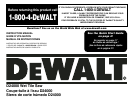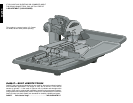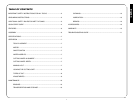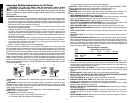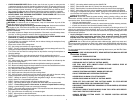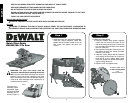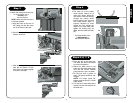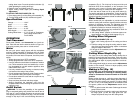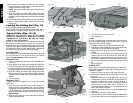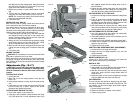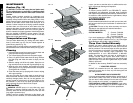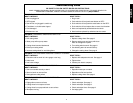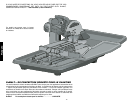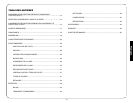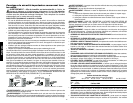
English
3
• CHECK DAMAGED PARTS. Before further use of the tool, a guard or other part that
is damaged should be carefully checked to determine that it will operate properly and
perform its intended function–check for alignment of moving parts, binding of moving
parts, breakage of parts, mounting, and any other conditions that may affect its opera-
tion. A guard or other part that is damaged should be properly repaired or replaced.
• DIRECTION OF FEED. Feed work into a cutting wheel with the direction of rotation only.
• NEVER LEAVE TOOL RUNNING UNATTENDED. TURN POWER OFF. Don’t leave
tool until it comes to a complete stop.
• REPLACEMENT PARTS. When servicing, use only identical replacement parts.
Additional Safety Rules for Wet Tile Saw
WARNING: To reduce the risk of electrocution, keep all connections dry and off the
ground. Do not touch plug with wet hands.
CAUTION: Wear appropriate hearing protection during use. Under some conditions
and duration of use, noise from this product may contribute to hearing loss.
CAUTION: Do not connect unit to electrical power source until complete instructions are
read and understood.
• Use safety equipment. Always wear eye protection. Dust mask, non-skid safety shoes,
hard hat, or hearing protection must be used for appropriate conditions.
• Keep hands out of path of saw cutting wheel. NEVER CUT A PIECE WHERE HAND
WOULD BE 3" (76mm) OR LESS FROM CUTTING WHEEL.
• Do not operate saw without cover in place.
• Do not perform any operation freehand, that is without holding the workpiece firmly
against the fence and guide.
• Never reach in back of the cutting wheel.
• DO - Use cutting cart extension to support large tile.
• DON’T - Cut dry. If cutting wheel is not cooled with water, serious damage will occur. Dry
cutting will increase exposure to harmful airborne dust.
• Turn off the tool and wait for cutting wheel to stop before moving the workpiece or
changing settings.
• To reduce risk of injury, return the carriage to the full rear position after each cut.
• DO - Protect electric supply line with at least a 15 ampere time-delay fuse or a circuit
breaker.
• DO - Make certain the cutting wheel rotates in the correct direction as indicated by the
arrow on the cutting wheel.
• DO - Be sure all clamp handles and knobs are tight before starting any operation.
• DO - Be sure all cutting wheel and clamp washers are clean and recessed sides of collars
are against cutting wheel. Tighten arbor screw securely.
• DO - Keep the cutting wheel properly aligned.
• DO - Keep the motor air slots free of chips and dirt.
• DO - Keep hands out of the path of the saw cutting wheel.
• DO - Shut off power, disconnect cord from power source and wait for the saw cutting
wheel to stop before servicing, adjusting tool or changing cutting wheel.
• DON’T - Attempt to operate on anything but designated voltage. Incorrect voltage may
result in shock, fire, or unpredictable operation.
• DON’T - Operate unless all knobs and clamp handles are tight.
• DON’T - Use cutting wheels larger or smaller than those which are recommended.
• DON’T - Force cutting action. Allow motor to reach full speed before cutting.
Stalling or partial stalling of motor can cause major damage.
• DON’T - Use metal cutting abrasive wheels. The excessive heat and abrasive particles
generated by them will damage the saw.
• DO - Use continuous rim wheels only, no serrated edges.
• DON’T - Allow anyone to stand behind saw.
• DON’T - Place either hand in the cutting wheel area when the saw is connected to the
power source.
• DON’T - Use cutting wheels rated less than 5000 R.P.M.
• DON’T - Place hands closer than 3" (76 mm) from the saw cutting wheel.
• DON’T - Reach behind or underneath the saw unless it is turned off and unplugged.
• DON’T - Move either hand from saw or workpiece until the cutting wheel has stopped.
• If the plug or receptacle does get wet. DON’T unplug the cord. Disconnect the fuse or
circuit breaker that supplies power to the tool. Then unplug and examine for presence
of water in the receptacle.
WARNING: Some dust created by power sanding, sawing, grinding, drilling, and other
construction activities contains chemicals known to cause cancer, birth defects or other
reproductive harm. Some examples of these chemicals are:
• lead from lead-based paints,
• crystalline silica from bricks, cement, tile, natural stone and other masonry products,
• arsenic and chromium from chemically-treated lumber (CCA).
Your risk from these exposures varies, depending on how often you do this type of work. To
reduce your exposure to these chemicals: work in a well ventilated area, and work with
approved safety equipment, such as those dust masks that are specially designed to filter
out microscopic particles.
• Avoid prolonged contact with dust from power sanding, sawing, grinding,
drilling, and other construction activities. Wear protective clothing and wash
exposed areas with soap and water. Allowing dust to get into your mouth, eyes, or
lay on the skin may promote absorption of harmful chemicals.
WARNING: Use of this tool can generate and/or disburse dust, which may cause seri-
ous and permanent respiratory or other injury. Always use NIOSH/OSHA approved respi-
ratory protection appropriate for the dust exposure. Direct particles away from face and
body.
For your convenience and safety, the following warning labels are on your Wet Tile Cutter.
ON COLUMN
WARNING: FOR YOUR OWN SAFETY, READ INSTRUCTION MANUAL BEFORE
OPERATING TILE SAW.
ALWAYS USE EYE PROTECTION.
ALWAYS USE PROPER RESPIRATORY PROTECTION.
KEEP HANDS OUT OF PATH OF CUTTING WHEEL.
USE TOOL ONLY WITH SMOOTH EDGE CUTTING WHEELS FREE OF
OPENINGS AND GROOVES.
DO NOT OPERATE SAW WITHOUT COVERS IN PLACE.
ALWAYS TIGHTEN ADJUSTMENT KNOBS BEFORE USE.
DO NOT PERFORM ANY OPERATION FREEHAND.
NEVER REACH IN BACK OF CUTTING WHEEL.
NEVER CROSS ARMS IN FRONT OF CUTTING WHEEL.
TURN OFF TOOL AND WAIT FOR CUTTING WHEEL TO STOP BEFORE
MOVING WORK PIECE OR CHANGING SETTINGS.
DISCONNECT POWER BEFORE CHANGING CUTTING WHEELS, SERVICING
OR CLEANING.
TO REDUCE RISK OF INJURY ALWAYS PLUG TOOL INTO A GFCI RECEP-
TACLE AND TEST GFCI BEFORE USE.
ALWAYS RETURN CUTTING WHEEL TO PROPER POSITION BEFORE
TURNING ON SAW.



